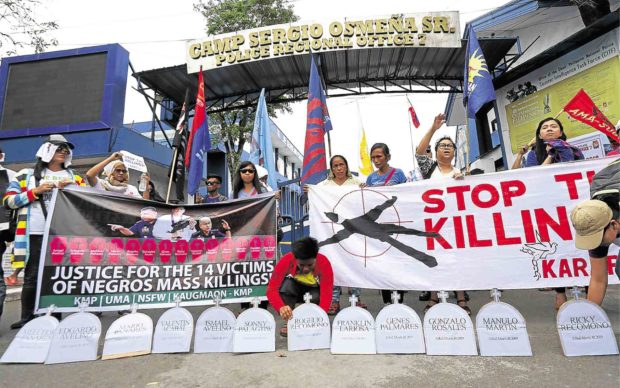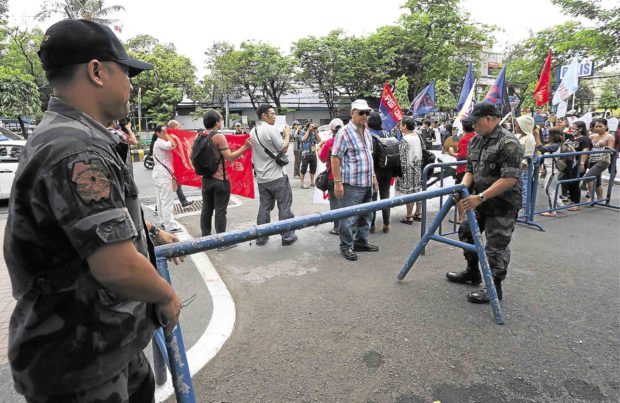Kids of slain Negros farmers show signs of trauma, kin say

OUTRAGE Police officers set up steel barricades (bottom) at Camp Sergio Osmeña Sr. when activists staged a rally there on April 8 to protest the killing of 14 farmers in Canlaon City and the towns of Manjuyog and Santa Catalina in Negros Oriental.

She kept on seeing in her dreams how armed operatives killed her father after they barged into their house in Canlaon City, Negros Oriental, early morning of March 30.
When she was awake, she told family members that she kept on seeing her father and uncle waiving at her.
Edgardo and his brother, Ismael, were among the 14 farmers killed by joint police and military operatives in simultaneous raids on loose firearms and explosives in the towns of Manjuyod and Santa Catalina and Canlaon City, Negros Oriental, on March 30.
The police officials, however, claimed that the 14 fought against a team composed of the Regional Public Safety Battalion, the elite Special Action Force and soldiers.
Article continues after this advertisementThe Philippine National Police and Malacañang also justified the raids saying these were covered by search warrants on suspected members or supporters of the New People’s Army.
Article continues after this advertisementBut families of those who died and 15 arrested maintained that they were farmers and not communist rebels.
Edgardo was the chairman of Hugpong Kusog sa Mag-uuma sa Canlaon City, a local chapter of the national peasant group Kilusang Magbubukid ng Pilipinas.
Two of the four killed in Manjuyod were village chiefs — Valentin Acabal and Sonny Palagtiw. The two others were farmers Steve Arapoc and Manulo Martin.
Aside from the Avelino brothers, the other fatalities in Canlaon were Melchor Panares, 67, and his son, Mario, 46; Rogelio Recomono, 52 and his son Ricky, 28; Gonzalo Rosales, 47 and Genes Palmares, 54.
Those killed in Santa Catalina were Franklin Lariosa and Ano Enojo Rapada.
Cynthia Avelino, daughter of Ismael, said they were worried about their 16-year-old cousin who had shown trauma over what happened to her father.
“She sometimes speaks to herself and keeps on telling us she has seen her father and uncle waving at her,” Cynthia said.
According to the results of the fact-finding investigation conducted by 21 human rights and peasant organizations, Edgardo’s daughter suffered a nervous breakdown after seeing how operatives killed her father.
Edgardo was shot twice in the chest and once in the center of his forehead, according to a 12-page report dubbed as National Fact-Finding and Solidarity Mission that was released on Monday.
The group asked that the families of the victims be given psychosocial assistance, especially those who witnessed the killings.
It said Lariosa’s two children age 4 and 9 saw how their father was killed by the operatives.
“Lariosa’s 4-year-old son was right beside him when he was shot and killed by the raiding team,” the report said.
The report said that Ismael’s two children, age 10 and 5, were forced out of the room by the armed operatives just before he was shot multiple times while lying on his bed.
Three of Arapoc’s 10 siblings — age 14, 10 and 6 — were also in the house when Arapoc was shot several times while sprawling on the sala.
“The victims’ family members had to endure the sight of their loved ones’ bodies bearing horrific wounds, carried or dragged away by members of the raiding teams and unceremoniously dumped into trucks,” the report said.
After the killings, relatives and neighbors had also been sleeping in a close cluster of houses due to fear, Cynthia said.
“It’s crowded in the houses but we feel safer that way,” she said.
The PNP relieved the Negros Oriental police director and the chiefs of police of the three local governments to pave for an investigation.
But Cynthia said this was not enough.
“They might just be transferred later on and they were not really the ones who led and primarily implemented the operations,” she said in Hiligaynon.